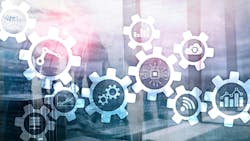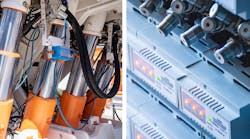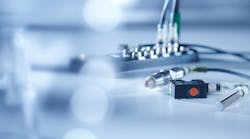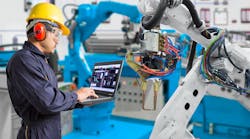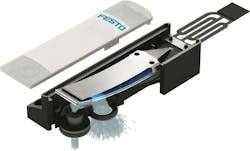Digitalization Improves Performance of Hydraulics and Pneumatics
Digitalization is a term that can encompass many things and take various forms when implemented. It often involves integration of sensors, software and controllers to improve the performance of systems and machines.
The fluid power industry is one of the many sectors in which digitalization is increasing, helping to bring about a range of performance enhancements that are helping to keep hydraulics and pneumatics as a motion control technology of choice.
Watch the Full Webinar for More Insights on Digitalization
Register for on-demand viewing of the webinar “How Digitalization of Fluid Power is Enabling New Technological Advancements” which took place February 26, 2025, for the full discussion between Langro, Pont and Keller.
In this excerpt from Power & Motion’s webinar “How Digitalization of Fluid Power is Enabling New Technological Advancements” three fluid power industry experts – Frank Langro, Director of Product Market Management, Pneumatic Automation, North America, Festo; Marcus Pont, CEO, Domin; and Nate Keller, Ph.D., Business Development Manager, Moog Construction – provide their insight on what the term digitalization means and how it is being employed in hydraulic and pneumatic systems.
*Editor's Note: Questions and responses have been edited for clarity.
Power & Motion (P&M): How do you or your company define digitalization?
Frank Langro, Festo: Digitalization is one of those buzz words that you hear a lot about now. At Festo, how we define digitalization [is] we really tie it very closely to the customer journey from the product selection on through the whole product life cycle, because you start to bring digitalization into the products themselves. Right at the beginning [when] you are using web tools, for instance, to size or design a component, putting it into your shopping basket, all the way to grabbing digital data from the product to enable commissioning, troubleshooting or just overall machine monitoring. Digitalization really expands from cradle to grave in our view.
Marcus Pont, Domin: I'd agree a lot with what Frank said there. It's a word that means a lot of things at the same time and a lot of different things to a lot of different people. I most commonly see it used to try and communicate that a company is doing things in a modern way, and that's the message that people want heard when they say that. At Domin, we're really keen on language, and really keen to ensure that language creates common understanding and helps give a bit of meaning out of what can sometimes be complex things. And Frank's absolutely right, there's the customer journey side, there's the tools that you use in your business and at the product.
[I'll share] what we think of digitalization at a product level for Domin. We break it down into three different areas within our hydraulic products. The first is the most simple and it's just the means with which you communicate to the product, the means with which you control a product. And so, for example, that might mean that instead of using current or voltage to communicate a demand signal you use a digital communication protocol such as Ethernet, EtherCAT, CANopen or anything like that. At its most basic, this allows for a more simple, more advanced and even more effective control and communication of a product. The second thing that we think about is configuration, and that's where we start thinking about being able to change almost the personality of a product via software. So rather than having to change the hardware, we're changing the way that the product behaves via software. And that's the next stage of digitalization for Domin.
Within our products the final stage for us is around a fully digital hydraulic system. And that's a big, complex thing that we can spend a lot of time talking about another time. But if I were to give you an analogy, it's about digitally controlling hydraulic fluid in a similar way that transistors digitally control electrical current. Historically, we started with electrical resistors, and we moved to transistors, and we believe the future of hydraulics ends up with that kind of transistor-level control of hydraulics, and we think that has the same potential and the same impact that electrical transistors had on that industry.
Nate Keller, Moog Construction: [Total agreement with] Frank and Marcus, and I love the three levels Marcus spoke to. So, I'll speak from a little bit of a higher level; digitalization as we see it is the process of changing from analog to digital. In the off-highway vehicle sector, it involves transforming vehicles from simply completing tasks [such as doing] functions like picking up a boulder or digging in the dirt. It changes from just performing a simple task to now doing it efficiently, productively and safely. This transformation is achieved by incorporating electronic sensors that gather this important machine information.
And as Marcus said, instead of communicating analog now you’re communicating digitally, as well as [incorporating] an intelligent motion control system, or an intelligent controller that collects, organizes and processes all of that data, and then it can execute commands to optimize the operation of the machine. As far as Moog Construction is concerned, we're more focused on the off-highway sector which is a very large sector for the mobile hydraulics market, [and] we definitely see digitalization as the key next step for this industry.
View the below content to learn more about digitalization in fluid power and other motion control technologies.
P&M: What are some of the technologies you see being employed in the fluid power industry to aid with digitalization of hydraulics and pneumatics, and of these what technologies is your company currently utilizing or evaluating?
Nate Keller, Moog Construction: Generally speaking, the first technologies that come to mind…[and] are fundamental to digitalization are sensors and controllers. However, sensors and controllers can only do so much with the physical hardware, such as valves, because this physical hardware is so critical to the performance, efficiency and capability of the machines that these hydraulic systems are working on.
For example, an excavator operator may be demanding finer, more precise control. Position sensors and a controller can certainly help with that control. But you can only go so far. And as Marcus spoke to earlier, you have to at some point start changing hardware if you want to make the control even better. So, for example, you would need to change the control valve, the null cut on the control valve, or go to a different type of control valve to get you in finer control. Well, Moog Construction helps OEMs create the next generation machines that allows for the machine to really be infinitely tunable because it's digitalized. You can tune the control and the feel of the machine without having to change hardware. You're able to flash that [with] over-the-air updates through software without having to modify that hardware.
We have developed and manufactured several technologies here at Moog; core digitalization technology at Moog Construction is our ruggedized electronic solution which consists of control, power management, thermal management, and tunable software that completely integrate with the machine. But then you take the controller and sensors, and you now integrate them with other products that Moog also can provide [such as] electric motors and electromechanical actuators. Now at this point, you have a full system that can communicate with…the sensors, the controller and you can do over-the-air updates without having to change hardware of the system.
One other area that Moog has a long, extensive history is in what are called electrohydrostatic actuators, or EHA. This is another way of saying that hydraulics is not going away, and we know that. If electromechanical actuators are not the right fit for a particular application, well then maybe something like an EHA would be. EHA eliminates these valves, and you would be able to, with the sensor and controller, now do fine adjustments and have a more digitalized hydraulic system.
Marcus Pont, Domin: Electromechanical has somewhat of an advantage at the moment with respect to digitalization, because, like Nate said, you have to have electrical sensors, electrical controllers. You've got to be able to measure things within a product. In order to be able to make it digital, you've got to know what is happening. Because just as Nate described, we've got to be able to make products more effective, more efficient, more intelligent, and to do that, the systems have to be able to make decisions. And to make decisions, they have to have knowledge, and to have knowledge, you've got to be able to measure things.
I think hydraulics is in a really interesting place at the moment where it needs to take a bit of a leap forward in order to catch up with that inherent advantage that electromechanical has, because it has electrics on it by definition. Where we see the technology being pulled to start off with is sometimes just in the most simple form in hydraulics, that is putting electronics inside the hydraulic components. So rather than having a really simple mechanical hydraulic component and then that being controlled from an electromechanical control system, we're seeing a real pull towards putting electronics onto the product where you're directly sensing, directly measuring and controlling within the product. We see that within our direct drive servo valves. A big pull from customers is to increase the level of intelligence in their systems by having electronics on board the valves.
The other thing that we've discovered over the journey is…often the limiting factor in hydraulics is not the ability to write software. It's not the ability to control things, it's the hardware. And one of the really great things for us is when we designed the products that we have, we already were in the world of digitalization, so the hardware has been designed with software and digital control and digital configurability in mind, and the example that Nate gave around null cut on a valve is something that we've thought about in the design of the hardware to ensure that we can do more with software than was previously possible with the hardware that's limited. Hydraulics is definitely not going away. What we're investing in is to ensure that all the benefits that hydraulics bring, which are numerous, broad and large, don't become outweighed by the downsides of not being digital.
And I love the electrohydrostatic actuator discussion. That's something that we see as a real steppingstone towards achieving that, and it's a big part of the technology that we're developing in Domin. We've seen, again, real pull from our customers to put that into a real variety of applications in order to add that value proposition for them. And I think we'll see ever more pull towards that as people are trying electromechanical in some of these spaces, and just realizing that it doesn't achieve the goal for the vehicle, and having to requestion that and say, “Okay, we want the benefits of hydraulics, but we don't want to give up the fact that we can sense and we know what's happening” and that's where we see this push within what we're doing.
Frank Langro, Festo: It's interesting taking the perspectives from three different companies in different technology areas, doing things slightly differently, but coming back to the same basics of digitalization. Our emphasis has really been on software development where we build data models to replicate pneumatic functionality. And this becomes very important in understanding how a pneumatic system, a pneumatic device, works so that you can start to think about how to predict this behavior going forward.
Software is a key piece here, but hardware and hardware limitations were also mentioned – we’ve seen hardware limitations, for instance, with the pneumatic valve. For many years, pneumatic valves have typically been actuated with solenoids, and they have their limitations. What we've been doing is using piezo electrics as the valve actuation. Applying software to that piezoelectric actuator has opened up a whole other world of how do I, using Marcus’ term, change the personality of that valve.
The software is changing the personality of the product. And so now that physical hardware can be used to do different things. You see in a lot of industries machine changeover; rather than shutting a machine down and retooling to run different product lines, with the push of a button, a menu change, a program trigger you change the way that machine is running because of a different product size or a different force requirement and so that's [enabled by] the software being inherent in the product.
About the Author
Sara Jensen
Executive Editor, Power & Motion
Sara Jensen is executive editor of Power & Motion, directing expanded coverage into the modern fluid power space, as well as mechatronic and smart technologies. She has over 15 years of publishing experience. Prior to Power & Motion she spent 11 years with a trade publication for engineers of heavy-duty equipment, the last 3 of which were as the editor and brand lead. Over the course of her time in the B2B industry, Sara has gained an extensive knowledge of various heavy-duty equipment industries — including construction, agriculture, mining and on-road trucks —along with the systems and market trends which impact them such as fluid power and electronic motion control technologies.
You can follow Sara and Power & Motion via the following social media handles:
X (formerly Twitter): @TechnlgyEditor and @PowerMotionTech
LinkedIn: @SaraJensen and @Power&Motion
Facebook: @PowerMotionTech
